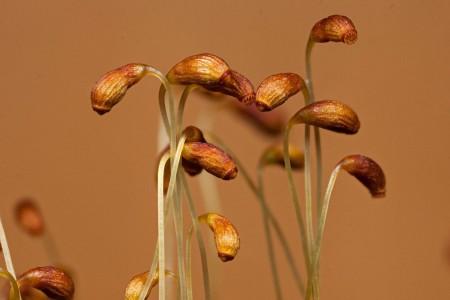
Funaria-hygrometrica-21-450×300.jpg from: https://ohiomosslichen.org/moss-funaria-hygrometrica/
Funaria trumpffii: A Fascinating Moss of the Funariaceae Family
Funaria trumpffii (Müll.Hal.) Broth., commonly known as Funaria, is a captivating species of moss belonging to the Funariaceae family. As a member of the Bryophyta division and Bryopsida class, this tiny plant plays a significant role in its ecosystems. In this blog post, we’ll dive into the world of Funaria trumpffii and explore its morphology, global distribution, habitat, ecological roles, and adaptations.
Background
Mosses are small, non-vascular plants that belong to the division Bryophyta. They lack true roots, stems, and leaves, instead possessing leaf-like structures called phyllids. Mosses play crucial roles in their ecosystems, contributing to nutrient cycling, water retention, and providing habitats for various organisms.
Morphology and Identification
Funaria trumpffii is a small, acrocarpous moss, meaning it bears sporophytes at the tips of its stems. The plants form loose tufts or mats, typically growing up to 1 cm tall. The leaves are ovate to lanceolate, with a pointed apex and a costa (midrib) that extends to the leaf tip. The leaf margins are entire or slightly toothed.

original.jpg from: https://www.gbif.org/es/species/2673552
The most distinctive feature of Funaria trumpffii is its capsule, which is pear-shaped and asymmetrical, with a long, curved neck. The capsule is borne on a seta (stalk) that can reach up to 2 cm in length. The peristome, a ring of teeth surrounding the capsule mouth, is double, with the outer teeth being shorter than the inner ones.
Global Distribution and Habitat
Funaria trumpffii has a wide distribution, occurring in various regions worldwide, including Europe, Asia, Africa, and the Americas. It is found in a variety of habitats, such as disturbed soils, burnt areas, and exposed mineral soils. This moss is often associated with human-influenced environments, such as roadsides, gardens, and agricultural fields.
Ecological Roles and Adaptations
Funaria trumpffii plays several important ecological roles:
- Soil stabilization: The moss helps to stabilize the soil surface, reducing erosion and promoting the establishment of other plant species.
- Nutrient cycling: Funaria trumpffii contributes to nutrient cycling by trapping and retaining nutrients from the atmosphere and decomposing organic matter.
- Water retention: The moss acts as a sponge, absorbing and retaining water, which helps to regulate moisture levels in its immediate environment.
- Habitat provision: Funaria trumpffii provides micro-habitats for various small organisms, such as insects, mites, and nematodes.
To thrive in its habitats, Funaria trumpffii has developed several adaptations:
- Desiccation tolerance: The moss can withstand periods of drought by entering a dormant state and quickly reviving when moisture becomes available.
- Spore dispersal: The asymmetrical capsule and double peristome facilitate spore dispersal by wind, allowing the moss to colonize new areas effectively.
- Rapid life cycle: Funaria trumpffii has a relatively short life cycle, enabling it to quickly colonize disturbed habitats and complete its reproductive cycle before environmental conditions become unfavorable.
Conclusion
Funaria trumpffii (Müll.Hal.) Broth. is a fascinating moss species that plays crucial roles in its ecosystems. Its unique morphology, wide distribution, and adaptations make it a resilient and successful plant. As we continue to study and appreciate the importance of mosses like Funaria trumpffii, we gain a deeper understanding of the complex interactions and processes that shape our world. So the next time you come across a small, inconspicuous moss, take a moment to marvel at its beauty and the vital functions it performs in nature.